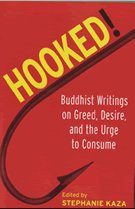Hooked!: Buddhist Writings on Greed, Desire, and the Urge to Consume

Chapter headings:
- Foreword: Paul Hawken
- Introduction: Stephanie Kaza
- Part One Getting Hooked: Desire and Attachment
- 1. Desire, delusion and DVDs: Joseph Goldstein
- 2. How we get hooked, how we get unhooked: Pema Chödrön
- 3. The inner pursuit of happiness: Ruben L.F. Habito
- 4. Young Buddhists in shopping Shangri-la: Sumi Loundon
- 5. Marketing the Dharma: Thubten Chödrön
- 6. You are what you download: Diana Winston
- Part Two Practicing with Desire: Using Buddhist Tools
- 7. Cultivating the wisdom gaze: Judith Simmer-Brown
- 8. No river bigger than Tanha: Pracha Hutanuwatr and Jane Rasbash
- 9. Taming the “I want” mind: Sunyana Graef
- 10. Penetrating the tangle: Stephanie Kaza
- 11. Form and elegance with just enough: Rita M. Gross
- 12. Consuming time: David Loy and Linda Goodhew
- Part Three Buddhist Ethics of Consumption
- 13. Three robes is enough: Ajahn Amaro
- 14. Practicing generosity in a consumer world: Santikaro
- 15. Wash your bowls: Norman Fischer
- 16. Green power in contemporary Japan: Duncan Ryuken Williams
- 17. Mutual Correction: David W. Chappell
- Notes
- Contributors
Selected excerpts:
“Those of us with strong addictions know that working with habitual patterns begins with the willingness to fully acknowledge our urge, and then the willingness not to act on it. This business of not acting out is called refraining. Traditionally it is known as renunciation. What we renounce or refrain from is not food, things, sex, or relationships per se. We renounce and refrain from the shenpa [“the urge”, the “hook”, “that sticky feeling”] When we talk about refraining from shenpa, we do not mean trying to cast it out; we mean trying to see the shenpa clearly and experiencing it. If we can see shenpa just as we are starting to close down, when we feel the tightening, then the possibility exists to catch the urge to do the habitual thing and to choose not to do it…….”We practice staying with the uneasiness, the tightening, the itch of shenpa. We train in sitting still with our desires, with our conditioned hooks. This is how we learn to stop the chain reaction of habitual patterns that otherwise rule our lives. This is how we weaken the patterns that keep us hooked into discomfort that we mistake as comfort.”
© 2003 Pema Chödrön (reprinted from Shambhala Sun March 2003)
Order this book online at Amazon
Reviews posted:
Paul –
I once asked a Buddhist friend what he thought the Buddha would have made of this website. His reply was “the Buddha would have said we were all addicts”. Although Hooked! focuses primarily on consumerism, it shines a light upon patterns of habitual behaviour that have a clear overlap with the Buddhist Recovery genre, and there are passages (such as the one from Pema Chödrön quoted above) that directly touch on more hard core clinical addictions. If you are looking for an in-depth discussion of chemical or alcohol addictions, then don’t buy this book. But if you are looking for inspiration to help you live more simply and lightly, and help in navigating the ethical minefield of the twenty first century supermarket, then this will be of interest. It has some fabulous essays on Buddhism. For example, the essay “Consuming time” by David Loy and Linda Goodhew really took my appreciation of conditionality up a notch. There are also some great Engaged Buddhist essays emphasising the goal of transforming society as well as ourselves. There is a lovely haiku-like poem I will have to get made into a T-shirt (quoted by Santikaro [whose audio lectures are reviewed on this website], adapted from David Loy):
The meaning of my life
Buying and owning things
Then throwing them away.
Michael –
Over two and a half thousand years ago the Buddha taught that there is suffering and a cause of suffering. The cause being our own craving and desire for more. The Pali word tanha means thirst, craving or desire. I am very much reminded that in the Buddhist canon there are six mind-states or realms, one of which is called the realm of the hungry ghosts, petti-visaya in Pali. These wretched beings are often described as having a distended belly and a tiny mouth, a graphic representation of insatiable and unquenchable hunger. For those of us who have experienced addiction, we need no convincing of the pain that can be caused by tanha. For what is addiction but tanha taken to its most destructive and obscene heights. And for me those hungry ghosts are not mere canonical or psychological realms, but indeed once my very reality. I agree with Paul that this book does not provide an in-depth discussion on addition. Rather, it looks at craving and desire in a much broader and general sense. Does our Western need to constantly consume and gratify ultimately make us happy? Do we ever stop to think and ask ourselves what our consumerist and throw- away society is doing to the environment? I am reminded of the old saying that ‘the things you own, end up owning you.’ I found this book a powerful reminder to live life more simply, and a touchstone of awareness for those areas of my life that habitually still hook me in. Everything from TV, to food, and even sex. There are indeed some great essays here. Paul’s quote of Santikaro’s poem above reminds me of some graffiti that appeared on the footpath of a park just outside Central Station here in Sydney. This book is a lesson that there is so much more than to simply:
Work
Consume
Be silent
Die!
